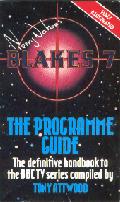Blake's 7 The Programme Guide
Written by: Tony Attwood
First Published: 1982
Page Count: 192
B/W Photographs: 13
Availability: Try Amazon

Viewpoint:
In an age where programme information is readily available on the Internet, and the episodes are widely available on tape, then the need for a paper programme guide suddenly seems less, to the point of it being virtually obselete. Yet back in 1982, when it was first published (and it's had many reprints, the version pictured being its fourth run in 1991), it probably seemed an essential purchase to any Blake's 7 fan.
In terms of content, then we get an introduction by Terry Nation, a prologue, a main cast list, then straight into an episode listing. Already the book has drawn short in retrospect: of the crews, then we only get writers, script editor, producer and director. We also get the guest cast, but no ratings or chart position. More saliantly, why were the episode titles and cast not mixed with the later episode summaries? Seperating the two is a small section on the background of the authors, which is quite interesting, if brief, and amuses with all the typos in Robert Holmes's entry.
In the middle of the book are some nice black and white photographs (again, you can get 'em on the Net these days), and a fairly static write-up of how the major characters saw each other. The Index of the series is a quite nice A-Z of the series, which shows a thoughtful attention to detail and knowledgable account of space. Occasional entries suggest elements from BBC documentation (Such as Gan being born on Zephron) that never found their way into the show, but generally this is one of the stronger elements of the book. The "Fan Clubs & Bibliography" is now hopelessly out of date, while the Interviews section - with Vere Lorrimer, Chris Boucher, Paul Darrow, Michael Keating and Peter Tuddenham is probably the best bit. Paul Darrow's is the most interesting, while Chris's seems to explain why he wrote Death-Watch. Finally, there's an (inaccurate?) account of where the characters were and whether they were still alive at the end of the series, which just seems to be a hard-sell lead-in to Attwood's post-series novel "Afterlife". Surely not?
In all, The Programme Guide now throws up the limitations of a printed work, unlike the Net, which can contain vastly more info than a small paperback, and be regularly updated. If you like lists, then it's for you. It's nothing particularly good, nothing particularly bad, it just is what it is. I guess I'm not that big a fan of Programme Guides, that's all...


